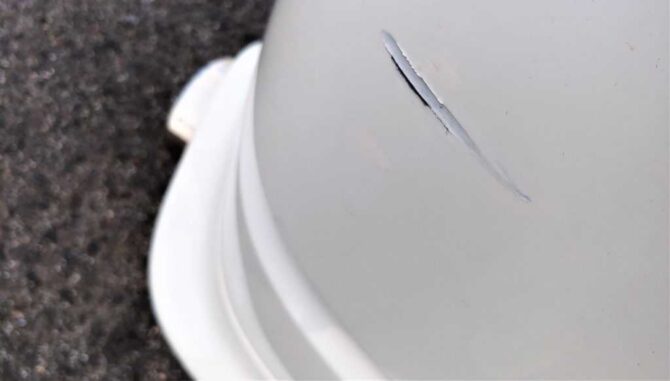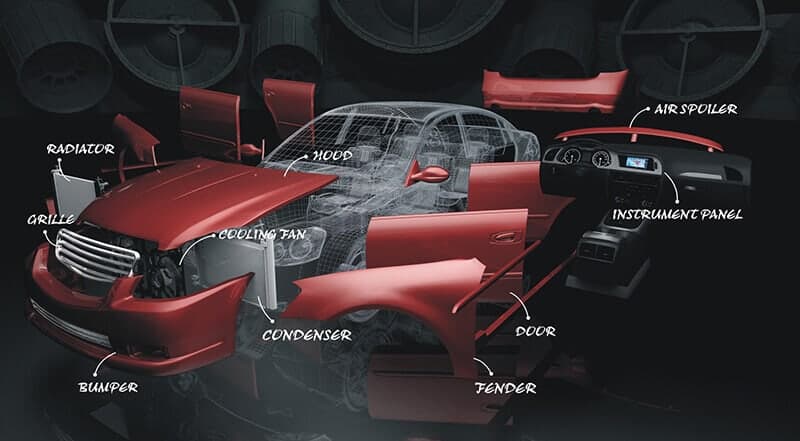Bobbing about, like falsified flotsam, floating upon a sea of misinformation, ceramic coating myths pollute the internet with their ilk.
“Looking to repel rocks, fend-off flames, and make routine scrubbing a thing of the past? You need the latest and greatest ’17H-rated’ nano ceramic coating!”
“But wait… there’s more! Are you unhappy with your vehicle’s flaccid performance specs? Slather some ceramic coating on its ass and watch that rock hard product perform like Ron Jeremy on set in the 1970s!”
Riiiiiiight…..
False claims such a these would be laughable if they weren’t so damn misleading and overabundant…
Out of all of the mistruths surrounding ceramic coatings on the web, one of the greatest misnomers, is that a nano ceramic coating will hide paint blemishes, and fill scratches and swirl marks.
In today’s article, we’ll explain why ceramic coatings don’t hide, but amplify blemishes, and how applying a ceramic coating can reduce these unattractive, and potentially hazardous external imperfections.
While we’re at it, we might as well discuss a few of our favorite ways of properly repairing swirl marks and scratches. Just in case you have another little “run in” with those overgrown hydrangeas at the end of the driveway.
Do Ceramic Coatings Hide Scratches?

Regardless as to whether you are a hardcore DIY enthusiast, a professional automotive detailer, or someone who just wants to protect their vehicle’s exterior, ceramic coatings will always behave the same way once installed. It doesn’t matter if you have an immaculate exterior, faded and peeling paint, or swaths of scratches and swirl marks, ceramic coating products amplify whatever they coat.
Part of this is due to the whole “nano” part of the nano ceramic coating namesake, which stems from the millions of microscopic quartz particles packed into each bottle. While these nanoparticles will indeed seep into scratches and swirl marks to create a smooth, uniform shell, their transparent nature does not allow them to hide offensive surface flaws.
The result? A scratch or swirl mark that appears to be far more serious than it actually is.
Quick Nerd Note: Gritty paint correction substances, like polishing and cutting compounds, are designed to cut away at a clear coat, until the surface scratch or swirl mark is of equal thickness as its surroundings. This polishing procedure doubles as a way of relocating clear coating to areas where it is needed, like those scratches you are trying to hide. After which, a quick buff job is typically all that is required in order to heat the clear coating to a point where it can adhere to its new home.
What Does Ceramic Coating Do for Your Car’s Paint?

Ask a professional automotive detailer, like Pan the Organizer, why they prefer ceramic coatings, and chances are they’ll mention a glossy shine and surface protection, along with any number of the following reasons.
- Scratch Resistant: Ceramic coatings may be scratch resistant, but they are far from being “scratch proof.” However, small scratches in a ceramic coating can often be buffed out with the right products, tools, and amount of patience.
- Road Salt Repellent: Deicers and road salt are corrosive as all hell, and will eat away at a clear coat with the huger of a feral hog in a sweet potato patch. Ceramic coatings force these ice melting menaces to stick to their surface, instead of gnawing into the metal underneath.
- UV Vigilante: One of the biggest dangers to automotive paint are UV rays, the Ultra-Violet light radiation emitted by the sun. Ceramic coatings deflect this fade-inducing invisible threat, and absorb any additional harmful rays, like a sacrificial layer of skin that’s eager to feel the burn.
- Corrosion Controller: Acid rain, chemicals, and even animal waste (like bird droppings and bug splatter) can eat away at clear coats, and eventually, your vehicle’s paint job. Unlike car wax and other milder surface protectants, ceramic coatings either repel acidic substances, or prevent them from eating into the underlying clear coat.
- Hydrophobic Property Enhancer: The term hydrophobic relates to a surface’s ability to repel water, dust, debris, and other forms of contaminant. A fully cured ceramic coating is slick as all hell, making it extremely difficult for airborne particles and moisture to stick to them.
What Causes Swirl Marks To Form?

The garden variety swirl mark is oftentimes caused by either drying a freshly washed vehicle with a rough or filthy towel, scrubbing with contaminated microfiber mitts or sponges, or not using the two-bucket car wash method.
Some other common causes of swirl marks include:
- Polishing or buffing with old/contaminated pads
- Applying aggressive paint cleaners or polishing compounds
- Using polyester applicators
- Dusting with dirty surface cleaners
- Automated car washes
- Not rinsing a car prior to scrubbing (pre-washing)
- Placing a dirty car cover over the vehicle
Is it Possible to Prevent Swirl Marks?
You may not be able to completely eliminate swirl marks, but there are several ways to significantly reduce the risk of them forming.
Step #1: Use the Two-Bucket Method for Washing Your Car
Instead of taking your car down to the local automatic car wash (a steaming cesspool for swirl marks and nefarious forms of filth), hand wash it with the two-bucket method. It’s pretty amazing how much of a difference a bucket of decontaminating rinse water will make when it comes to reducing swirl marks. For more on this check out our article focusing on the art of detailing a car like a pro.
Step #2: Rinse Your Vehicle After Scrubbing Each Panel
Sudsy scrub-down complete, it’s time for a quick rinse, which should be conducted after completing one body panel or section. By doing this, you’ll remove any excess debris that might still be clinging to the surface, and it will keep the surface slick, which in turn will reduce the chance of scratches and swirl marks forming during the drying phase.
Step #3: Use a Clean Microfiber Towel to Remove Water
Speaking of the drying phase, a clean microfiber cloth is still without question the best product for removing standing water from a vehicle’s surfaces. That said, making sure that this synthetic textile is completely clean is also pretty damn vital, so if that towel looks filthy, set it aside and grab a fresh microfiber cloth from the stack.
Step #4: Apply a Ceramic Coating
Once the vehicle has been fully scrubbed and dried, it’s time to keep those pesky swirl marks and scratches at bay by applying a nano ceramic coating. This ultra-thin, exceptionally strong, super slick layer of protection can spell the difference between a flawless, gloss-rich clear coat, and an exterior that looks like it just survived the zombie apocalypse.
Quick Tip: Ceramic coatings are the ultimate surface scratch and swirl mark prevention plan. But in order to function properly, they must first feel at home on the surface they will be shielding. Always conduct the proper ceramic coating prep steps prior to applying a ceramic coating in order to guarantee that this lustrous armor lasts for years.
Can Swirl Marks Be Removed?

It is possible to remove swirl marks that are embedded in clear coating via the use of an electric polishing machine or buffer, along with a mild polishing compound. You can also opt for the old fashioned hand buffing approach, which relies upon a crosshatch technique, some patience, and a shit-ton of elbow grease.
While polishing and paint correction are definitely a messy and potentially risky endeavor, the act of eliminating aggressive swirl marks and scratches requires slightly more drastic measures.
Accompanied by a little clay decontamination action, and finished with a substantial amount of buffing, you can turn those swirl marks and minor surface scratches from an unsightly mess, to a distant memory in just a few hours.
Parting Shots

While investing in the right car washing supplies, and utilizing the proper techniques will indeed reduce the threat of swirl marks, there are no guarantees as to what will happen when your vehicle leaves a garage’s protection. Scratches come in all sorts of shapes, sizes, and unexpected surprises, especially when you are barreling down the interstate.
Having a sacrificial layer of nano ceramic coating sprawled across the exterior of your automobile may not prevent a scratch from occurring. But it will drastically reduce the significance of the damage, while eliminating swirl marks once and for all. So slap some Armor Shield IX on that ride, and give us a shout if you have any questions.












